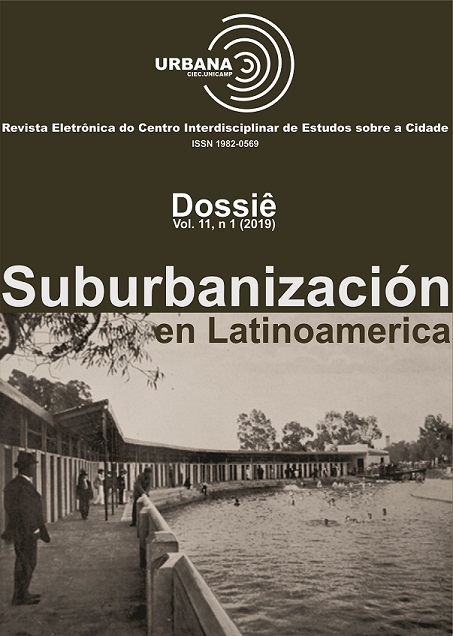Abstract
From the practical experience in urban planning and the teaching of urban history, we consider that the terms suburb and suburbanization do not enjoy a deep rooted as explanatory concepts of the processes that have determined the structure of urban areas in Mexico. The suburb in Mexico is usually thought of as a residential space located in the urban periphery, originally intended for the population with higher incomes and that in the twentieth century was expanded to include large sectors of the emerging middle classes. The irregular settlements that dominated the processes of urbanization in the last century are rarely conceived as suburbs although they share the peripheral location with those. In any case, in the periphery of Mexican cities, diverse urban morphologies are agglomerated that are not always the product of the influence of the Anglo-Saxon residential suburb, since they include high-density housing units, popular neighborhoods of informal origin with different degrees of consolidation, conurbated towns and, of course, formal subdivisions for middle and high income families with very diverse architectural typologies.References
ALCANTAR, Erika (2018). Fraccionadores y fraccionamientos: una historia del desarrollo inmobiliario en la Ciudad de México en el siglo XX a través de Ciudad Satélite y Villa Coapa. Tesis de maestría en urbanismo. México: Facultad de Arquitectura, UNAM.
ARTIUM, Luis Barragán. Recuperado el 20 de febrero de 2018 de: http://catalogo.artium.org/dossieres/exposiciones/premios-pritzker-viaje-por-la-arquitectura-contemporanea/pedregal-de-san
BOILS, Guillermo (2005). Pasado y presente de la colonia Santa María la Ribera. México: UAM-X.
CASA LUIS BARRAGÁN. Recuperado el 20 de febrero de 2018 de: http://www.casaluisbarragan.org/luisbarragan.html
DUHAU, Emilio; GIGLIA, Angela (2008). Las reglas del desorden: habitar la metrópoli. México: Siglo XXI.
EGGENER, Keith (1995). Luis Barragan’s El Pedregal and the making of Mexican Modernism: Architecture, Photogrpahy and critical. Stanford: Stanford University Department of Art.
FORSYTH, Ann (2012). Defining Suburbs. Journal of Planning Literature. U.S.A. V. 27, n. 3.
GARAY, Graciela; GARAY, Graciela (2011 [1954]). De cómo llegaron los suburbios modernistas a México. Ciudad Satélite. In: LLANOS, Fernando et al. Satélite, el libro: historias suburbanas en la Ciudad de México. México: UAM, 2011.
GOSSMAN, Rafael (1998). La gran corriente ornamental del siglo XX. Una revisión de la arquitectura neocolonial en la ciudad de México. México: Universidad Iberoamericana.
HALL, Peter Geoffrey (1996). Ciudades del Mañana. Barcelona:Ediciones del Serbal, S.A.
HAYDEN, Dolores (2003). Building Suburbia: Green Fields and Urban Growth, 1820-2000. New York: Pantheon Books.
HERNÁNDEZ GALVÉZ, Alejandro (2015). El Pedregal. Arquine. Recuperado el 16 de febrero de 2018 de: http://www.arquine.com/el-pedregal/
JIMÉNEZ MUÑOZ, Jorge (2012). La traza del poder. México: Secretaría de Cultura del Distrito Federal, UACM.
LOT, Antonio; CAMARENA, Pedro (2009). El Pedregal de San Ángel de la ciudad de México: reserva ecológica urbana de la Universidad Nacional. In: LOT, Antonio Lot; CANO-SANTANA, Zenón (2009). Biodiversidad del Pedregal de San Ángel. México: UNAM.
MANCEBO, José (1960). Las Lomas de Chapultepec: el rancho de Coscoacoaco y el Molino de Rey: estudio histórico, topográfico y jurídico. México: Porrúa.
MARTÍNEZ, Margarita (2011). La colonia de los arquitectos a través del tiempo San Rafael. México: Gobierno del Distrito Federal.
MIRANDA, Sergio (2005). Tacubaya de suburbio veraniego a ciudad. México: UNAM.
SITES (2018). Historia de las lomas de Chapultepec (s. f). Recuperado el 27 de febrero de 2018 de: https://sites.google.com/site/salvolomasorg/home/un-poco-de-historia-de-lomas-de-chapultepec
TELLO PEÓN, Berta (1998). Santa María la Ribera. México: Clío.
LLAMAS, Jorge Pedro Uribe (2015). Amor por la ciudad de México. México: Paralelo 21.
A URBANA: Revista Eletrônica do Centro Interdisciplinar de Estudos sobre a Cidade utiliza a licença do Creative Commons (CC), preservando assim, a integridade dos artigos em ambiente de acesso aberto.

